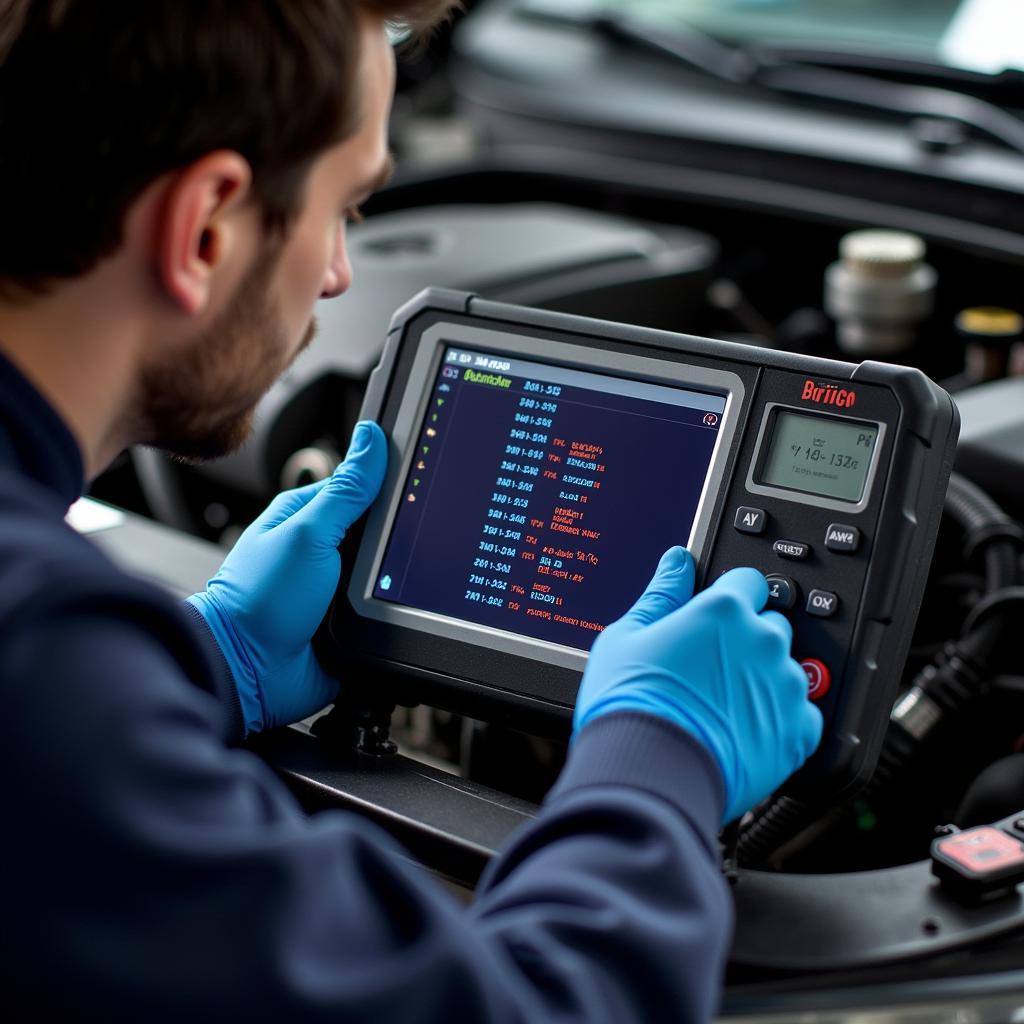Diagnostic testing on cars is a vital procedure that involves using electronic equipment to communicate with your car’s computer system. This system, also known as the Engine Control Unit (ECU), monitors and controls various aspects of your car’s performance, including engine function, emissions, and other critical components.
 Car Diagnostic Test Equipment
Car Diagnostic Test Equipment
Why is Diagnostic Testing Important?
Diagnostic testing plays a crucial role in modern car maintenance and repair for several key reasons:
-
Accurate Problem Identification: Diagnostic testing offers a precise method for pinpointing issues within your car’s complex systems. Instead of relying on guesswork or visual inspections alone, mechanics can use diagnostic tools to retrieve specific fault codes stored in the ECU. These codes act like clues, guiding mechanics directly to the root of the problem.
-
Time and Cost Efficiency: By quickly and accurately identifying car problems, diagnostic testing helps save both time and money. It eliminates the need for lengthy and often unnecessary trial-and-error repairs, which can be costly and time-consuming.
-
Preventative Maintenance: Regular diagnostic testing can identify minor issues before they escalate into major problems, helping you avoid costly repairs and breakdowns down the line. Think of it like a health check-up for your car, ensuring everything is running smoothly.
-
Improved Vehicle Performance: By addressing underlying issues, diagnostic testing can help optimize your car’s performance, leading to better fuel efficiency, smoother running, and a more enjoyable driving experience.
How Does Car Diagnostic Testing Work?
Car diagnostic testing relies on a standardized system known as OBD-II, or On-Board Diagnostics, which became mandatory for all cars manufactured after 1996. The process is relatively straightforward:
-
Connecting the Diagnostic Tool: A mechanic connects a specialized diagnostic tool to your car’s OBD-II port, usually located under the dashboard on the driver’s side.
-
Retrieving Fault Codes: The diagnostic tool communicates with the car’s ECU, retrieving stored fault codes that indicate specific issues or malfunctions.
-
Interpreting the Codes: Mechanics use their expertise and specialized software to interpret the retrieved codes, translating them into understandable diagnoses.
-
Further Investigation: In some cases, further investigation may be needed to fully diagnose the problem. This might involve visually inspecting components, checking wiring harnesses, or performing additional tests.
 Mechanic Analyzing Diagnostic Results
Mechanic Analyzing Diagnostic Results
What Can Diagnostic Testing Detect?
Diagnostic testing can detect a wide array of car problems, including:
- Engine Issues: Misfires, low compression, sensor malfunctions, and other engine-related problems.
- Transmission Problems: Slipping gears, rough shifting, and other transmission-related issues.
- Brake System Faults: ABS issues, brake fluid leaks, and other problems affecting the braking system.
- Electrical Issues: Wiring faults, battery problems, alternator issues, and other electrical malfunctions.
- Emissions System Problems: Faulty oxygen sensors, catalytic converter issues, and other emissions-related problems.
Who Does Diagnostic Testing on Cars?
Various automotive professionals can perform diagnostic testing, including:
- Dealerships: Dealerships have specialized technicians trained to diagnose and repair their brand of vehicles.
- Independent Mechanics: Many independent mechanics invest in diagnostic equipment and training to provide these services to their customers.
- Mobile Mechanics: Some mobile mechanics offer diagnostic testing as part of their on-site services, providing convenience for car owners.
Choosing the Right Diagnostic Tester
If you’re considering purchasing a diagnostic tool for personal use, it’s essential to choose one that meets your needs and budget. There are various types of diagnostic testers available, ranging from basic code readers to advanced professional-grade tools.
Basic Code Readers: These affordable devices can retrieve and display basic fault codes, providing a starting point for diagnosing simple issues.
Advanced Scan Tools: More sophisticated scan tools offer a broader range of features, including live data streaming, component activation, and access to manufacturer-specific codes.
Professional-Grade Diagnostic Systems: These high-end systems are typically used by dealerships and professional mechanics, providing comprehensive diagnostic capabilities and advanced functionalities.
 Different Types of Car Diagnostic Tools
Different Types of Car Diagnostic Tools
Frequently Asked Questions (FAQs)
How Often Should I Get a Diagnostic Test for My Car?
It’s generally recommended to have a diagnostic test performed annually or whenever you experience unusual car behavior, such as warning lights on the dashboard, strange noises, or performance issues.
Can I Perform a Diagnostic Test Myself?
Yes, basic diagnostic tests can be performed at home using affordable code readers. However, keep in mind that interpreting the codes and addressing complex issues often require the expertise of a qualified mechanic.
How Long Does a Diagnostic Test Take?
The duration of a diagnostic test can vary depending on the complexity of the issue and the specific tests performed. However, most basic diagnostic tests can be completed within 30 minutes to an hour.
Are Diagnostic Tests Covered Under Warranty?
Warranty coverage for diagnostic tests varies depending on the car manufacturer and the specific terms of your warranty. It’s always best to consult your warranty documentation or contact your dealer for clarification.
Can a Diagnostic Test Clear Electrical Faults on Cars?
While a diagnostic test can identify electrical faults, it may not necessarily clear them. Clearing electrical faults often requires addressing the underlying cause, such as repairing wiring issues, replacing faulty components, or resetting the ECU.
Conclusion
Diagnostic testing has become an indispensable part of modern car maintenance and repair. By providing accurate insights into your car’s health, diagnostic testing empowers car owners and mechanics to address issues promptly, preventing costly repairs and ensuring optimal vehicle performance. Whether you’re experiencing car trouble or simply want to stay ahead of potential problems, a diagnostic test is a valuable investment in the longevity and reliability of your vehicle.
If you need assistance with car diagnostic testing or have any concerns about your vehicle’s performance, don’t hesitate to contact us. You can reach our team of car diagnostic experts through WhatsApp at +1(641)206-8880 or email us at [email protected]. We are available 24/7 to answer your questions and provide expert guidance.

Leave a Reply